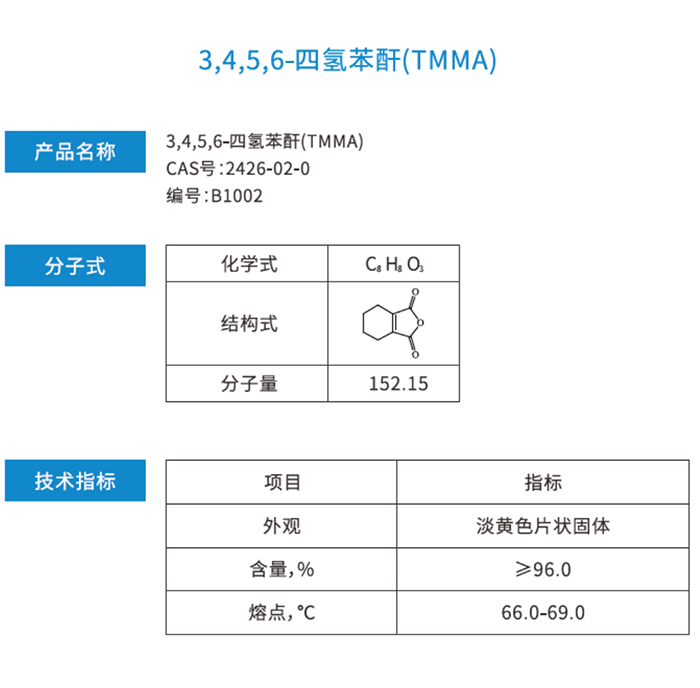
Tetrahydrophthalic anhydride is one of the downstream products of maleic anhydride. It is a high-performance new type of organic anhydride epoxy resin curing agent used for alkyd resins and unsaturated resins, which can improve the adhesion, elasticity, gloss, and water resistance of coatings. As a plasticizer, it can improve the cold and heat resistance of PVC, and is non-toxic. Widely used in the electronic and electrical industry, as well as in the aerospace industry. At the same time, this product is also a raw material for synthesizing surfactants and pharmaceutical pesticide products.
1. Epoxy resin curing agent
Epoxy resins without curing agents generally do not undergo chemical reactions with functional groups such as epoxy groups at room temperature or under heating conditions, and do not crosslink large molecules into bulk structures. Therefore, epoxy resins before use are collectively referred to as thermoplastic epoxy resins. Thermoplastic epoxy resin, especially with low molecular weight, lacks strength and must be cured and crosslinked before it can function effectively. The curing of epoxy resin mainly relies on the use of curing agents to open the epoxy bonds in the resin, indirectly or directly connecting the molecular structure of the epoxy resin, gradually forming a large molecular structure in one form. Curing agents can be divided into two types based on their curing mechanism. One type is to participate in the curing reaction and form a part of the chain segment of the cured product. These curing agents are called additive curing agents, such as primary amines, secondary amines, polyimides, polyamines, as well as various organic acids and anhydrides; Another type of curing agent that only undergoes catalytic reactions during the curing process, causing the resin itself to polymerize into a network structure, while the curing agent does not participate in cross-linking reactions, is called catalytic curing agent, such as tertiary amine, imidazole, boron trifluoride, etc. Some curing agents also have the above functions. The most commonly used curing agent for epoxy resin is * * * curing agent. THPA belongs to the * * * class anhydride curing agent.
The reaction mechanism of THPA in epoxy resin curing system is as follows: firstly, the hydroxyl group in the epoxy resin reacts with the anhydride to open the anhydride, and then undergoes addition polymerization reaction in the following order:
(1) Anhydride first reacts with hydroxyl groups in epoxy resin to generate carboxylic acid;
(2) Acid addition to epoxy group to generate hydroxyl group;
(3) The generated hydroxyl group continues to react with other acid anhydrides.
This reaction process is repeated to generate bulk polymers.
2. Other chemical intermediates
Tetrahydrophthalic anhydride is still an important chemical intermediate used in the synthesis of numerous chemical products, including 1,2,3,4-butanetetracarboxylic acid, hyperbranched polyester, and hexahydrophthalic anhydride.
Synthesis 1, 2, 3 4-Butane-tetracarboxylic acid:
Tetrahydrophthalic anhydride can be used to synthesize 1,2,3,4-butanetetracarboxylic acid (BTCA). 1,2,3,4-Butanetetracarboxylic acid is an important chemical product widely used in industries such as textiles, chemicals, metallurgy, and electronics.
